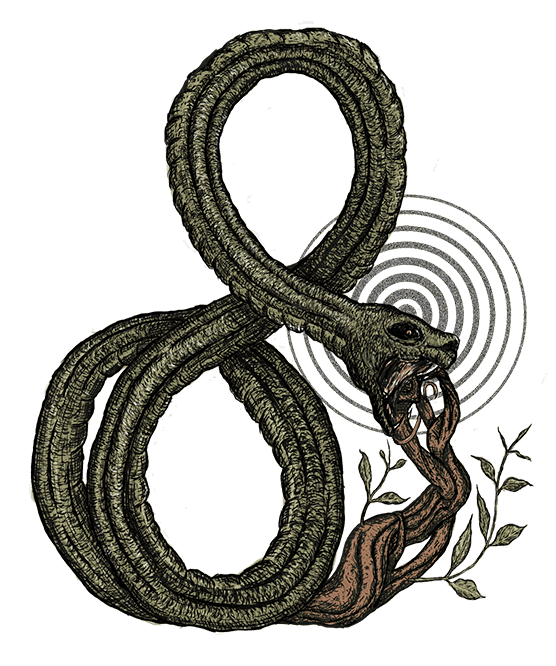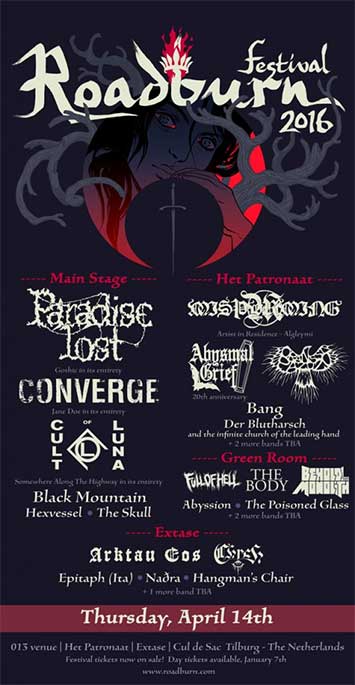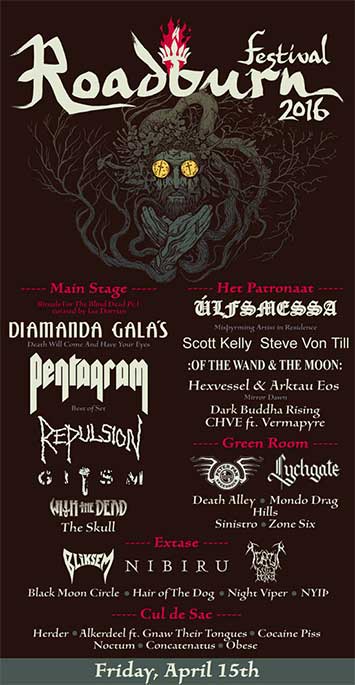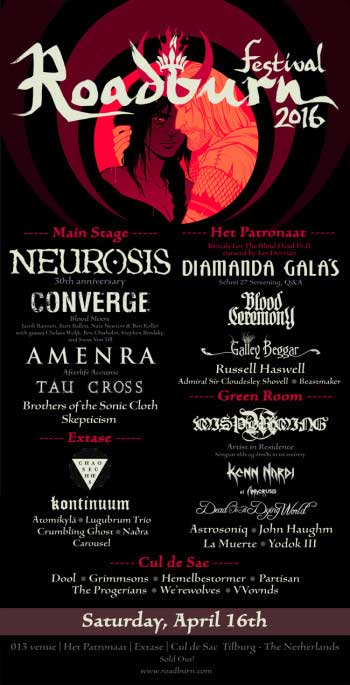Misþyrming II
2024-06-12
by Niklas Göransson
2015 marked a pivotal year for Icelandic black metal phenomenon Misþyrming. After a lauded debut and praised performances, D.G. forged a crooked path towards their follow-up album, Algleymi.
DAGUR: Before Inferno, I’d never been to a metal festival abroad, so I had no idea what to expect. Even though we played on a small stage quite early on the first day, there were so many people there to watch us perform.
MISÞYRMING’s debut album, “Söngvar elds og óreiðu”, was released by Terratur Possessions and Fallen Empire Records in February 2015. Reviews were stellar, and the vinyl edition sold out instantly. The band’s first gig abroad took place two months later, at Norway’s Inferno Festival.
DAGUR: It was interesting to see that there are even stronger underground scenes outside of Iceland. But being on stage didn’t feel any different because I’m not really trying to impress anyone; it’s more about the sense of catharsis I get from playing my music live.
In July of the same year, MISÞYRMING returned to Icelandic festival Eistnaflug as part of a curated performance known as Úlfsmessa, or ‘Wolf’s Mass’. Together with three other bands – NAÐRA, GRAFIR, and NYIÞ – they delivered a ninety-minute blend of droning ritual ambient and black metal.
DAGUR: All four bands share members, so the goal was to intertwine our performances into a seamless flow for the entire duration of the mass. One idea we had was to merge the dark ambient of NYIÞ with an unreleased MISÞYRMING song called “Hof”. The outcome was a big success, much like the previous year.
The first Úlfsmessa in 2014 was praised by Pitchfork, one of the leading contemporary music sites, which generated considerable press attention.
Similarly, the 2015 edition received accolades from various outlets that don’t typically cover black metal. The Reykjavik Grapevine highlighted ‘masked people stalking through the audience, staring intensely into people’s eyes’ and even described them physically accosting attendees.
DAGUR: That was no exaggeration; we wanted to keep pushing the boundaries. With four bands involved, it became clear that not all members would be on stage simultaneously. We now faced a decision: should everyone simply remain backstage awaiting their cue, or do we take things a step further? Several of us opted to intensify the crowd experience by walking into the audience and truly intimidating people.
After the Eistnaflug performance, Þórir Garðarsson of SVARTIDAUÐI and SINMARA sent Dagur a rehearsal recording of a new SINMARA song – “Ivory Stone” – and proposed a split EP.
DAGUR: I loved their track, so Helgi and I recorded “Hof” – the piece we used for the Úlfsmessa collaboration. This song came from the same period as “Söngvar…”, but I didn’t write it for MISÞYRMING specifically; I just wanted to create some dark death metal. The lines between death and black metal are increasingly blurred, particularly with amazing acts like TEITANBLOOD.
TEITANBLOOD is a Spanish band signed to NoEvDia. Their 2009 debut album, “Seven Chalices”, made a huge impression on the underground scene by masterfully merging the brutality of death metal with the solemnity and spiritual darkness of black metal.
DAGUR: That was the atmosphere I aimed for. The idea struck me like lightning one day, and I rushed home to capture the concept before it could slip away. At the time, I wasn’t certain that it had enough black metal elements; there are some dissonant guitar leads, but overall, “Hof” leans more towards death metal. However, I soon realised, ‘Why confine myself to a single style? I wrote the song, so of course it’s MISÞYRMING.’
Have you ever played it live?
DAGUR: A handful of times. Unfortunately, it’s our only song that uses drop-tuned guitars, and changing the tuning in the middle of a set is very impractical. We might start playing it again if MISÞYRMING can tour with multiple guitars per person. By then, perhaps we’ll have more such tracks; I plan to keep incorporating death metal elements.
In the same session as “Hof”, MISÞYRMING recorded an instrumental cover of “The God Supreme” from FUNERAL MIST’s 1998 mini-album “Devilry”.
DAGUR: We chose this song because it’s fucking ruthless. Out of the entire FUNERAL MIST discography, I’d say the “Devilry” material is best suited for playing live. Everything that follows is untouchable in terms of production quality. For example, you’d never jam “Holy Poison”: the version on “Salvation” is its ultimate rendition. But “Devilry” is different; it has a more direct rock ‘n’ roll approach. However, we didn’t dare add any vocals – there are some things you simply don’t tamper with.
Around the same time, MISÞYRMING were offered their second-ever show abroad, as Terratur secured them a slot at Norway’s Beyond the Gates. Coincidentally, MARDUK – featuring FUNERAL MIST mastermind Daniel Rostén on vocals – were booked to headline the same night.
DAGUR: I thought, ‘Should we ask Rostén to join us on stage?’ The notion made sense, but I forgot about it. Then, shortly before the festival – after a long night of partying – I suddenly remembered the idea. As soon as I got home, I wrote an email introducing myself, explained the idea, and provided a link to our recording. A week later, Rostén responded with a short message saying, ‘The cover sounds good, let’s do it. Don’t tell anyone.’ That’s when I saw my badly written email for the first time. Like, ‘Fuck! How messed up was I when I wrote that?’
So, come August 2015 – to the collective gasp of the entire metal internet – MISÞYRMING performed a FUNERAL MIST cover with the man himself on vocals.
DAGUR: Are you really gonna call it a ‘cover’ if he’s the one singing? <laughs> Well, I like to see it that way; it makes me seem much more arrogant. The plan was to meet up and get introduced during MARDUK’s soundcheck. Rostén told me not to announce anything and that he’d be ready by the stage towards the end of our set. Then we’d finish with “The God Supreme” – and that’s what happened.
Two months later, in October 2015, MISÞYRMING appeared at the Dutch festival Aurora Infernalis, sharing the stage with bands like ARCTURUS, HADES ALMIGHTY, KAMPFAR, and OFERMOD.
DAGUR: This was only MISÞYRMING’s third show overseas, so it felt like a big deal to us. Ole (Terratur Possessions), our label manager, initiated the discussion but then handed all communication to me. He warned me beforehand that some shady characters were involved, but we decided to proceed anyway. And sure enough, the festival turned out to be a total clusterfuck.
I’ve heard quite a few tales from this event – enough to conclude that ‘clusterfuck’ is indeed an apt description.
DAGUR: The organiser was completely incompetent and should never have been left in charge of anything. I’m pretty sure he went bankrupt and disappeared off the face of the earth afterwards. We flew in the day before our show and landed at five o’clock. However, the shuttle pickup got so fucked up that we had to drive back and forth from the airport twice.
By the time they reached the festival, it was already midnight. Frustration turned to despair as the promoter informed Dagur that MISÞYRMING had no accommodation.
DAGUR: While we were having this conversation, a local bar owner overheard us. He approached me and said, ‘Hey, my place is just around the corner – you can crash there if you want?’ We had no choice but to accept the offer. So, after his bar closed, we drank a few beers with the staff before making our way to a shitty backroom where dust-covered bunk beds awaited us. It wasn’t very nice.
The second day saw a last-minute overhaul of the festival’s running order. OFERMOD were now the first band on stage, while ARCTURUS relinquished their headline slot to MISÞYRMING.
DAGUR: It made absolutely no sense. The ticketholders were furious, like, ‘So we have to be there at 2 pm to see OFERMOD?’ And it unfolded just like that, with OFERMOD playing to a sleepy daytime crowd, followed by some bands I can’t remember throughout the afternoon and evening. The grand headliner, ARCTURUS, warmed up for us, and MISÞYRMING – a young, new band – closed the festival. Ridiculous.
How was your show?
DAGUR: The gig itself went great. Towards the end, we played “Frostauðn” – a dark ambient track from “Söngvar…” – through the sound system. Then, inspired by our Úlfsmessa earlier in the year, we walked into the crowd, grabbed people, and screamed at them. It definitely made an impact, and many audience members were visibly moved by the experience. However, we never repeated this; it was a unique occurrence that felt appropriate at the moment.
MISÞYRMING had marginally better luck with their lodgings on the second evening. After the show, they were brought to a nearby hostel.
DAGUR: It was very late, and we were a bit drunk and stoned. We had about five grams of weed and a bag of hash and wanted to finish it all. At our hostel, the grumpy, middle-aged receptionist insisted that we’d already checked in. He looked puzzled when I told him we only just arrived but eventually handed us a key.
Upon opening the door to their room, they found all beds occupied by members of OFERMOD.
DAGUR: We just peered in and went, ‘Fuck!’ Rudra, their bass player, was the only one awake, so he came out for a while. We returned to the desk and explained our predicament to the receptionist; he looked even more confused this time but ended up offering us his private accommodation. To his dismay, we rolled like seven joints and then went outside, so the remaining memories are somewhat unclear.
While the two Eistnaflug shows did much to spread the name of MISÞYRMING within metal circles, their November 2015 appearance at a commercial showcase festival called Iceland Airwaves generated a very different kind of notoriety.
DAGUR: We received a lot of attention from mainstream media early in our career. First, there was that unexpected Pitchfork column after Eistnaflug in 2014. Then we were booked for this Iceland Airwaves Festival, which had nothing to do with black metal. I’ve never attended as a guest myself – but if they book us, we can perform. To me, it was just another show.
Still, it must be rewarding to receive such widespread recognition.
DAGUR: Sure. Recognition isn’t necessarily the main goal, but success is always nice. However, such fans rarely stick around for long, so I don’t particularly care about them; they’re just opportunists. All these events were unpredictable, and none of the media exposure was ever my intention. Of course, press coverage is good for promoting the band and expanding our fanbase – but beyond that, it’s quite insignificant.
The following month, MISÞYRMING took part in Nidrosian Black Mass V in Brussels, Belgium. This gathering was brimming with black metal history, old and new, including a rare CLANDESTINE BLAZE performance.
DAGUR: Nidrosian Black Mass was the most exciting black metal event back then. Beyond the Gates had already given us a good introduction to the underground festival scene, but this brought everything to another level. It felt like a dream come true to share the line-up with so many incredible bands – truly an awe-inspiring experience. Then, some guy got shot just outside our hotel, so we woke up to yellow tape and police all around.
The festival was immediately followed by a tour with MGŁA, fellow Terratur band ONE TAIL, ONE HEAD, and KRINGA. This week-long venture introduced MISÞYRMING to many new territories.
DAGUR: We spent six days in a van listening to GUNS N’ ROSES – because that’s what our elders wanted to hear. It was a nice experience to open for MGŁA, who were reaching world-famous rockstar status by then. The final tour date took place at a huge venue in their hometown of Kraków; it was absolutely mad, and that’s where we filmed our first music video.
Was it immediately following this tour that you took a maths exam?
DAGUR: Yes, that’s right; I had to study some logarithmic bullshit. I dropped out of college – the kind you attend from age sixteen to twenty – after three years because I wasn’t engaged with the topics and saw no real purpose in graduating other than bolstering my CV. I even tried becoming an electrician for a while, but that didn’t resonate with me either. Eventually, I returned to a different college, determined to finish this time.
Dagur was a dedicated student for a year and a half – but then the MGŁA tour opportunity arose, coinciding with his finals.
DAGUR: It felt like a no-brainer; I chose the tour because that’s what I wanna do with my life. Should I refuse it, such an opportunity might never come again. So, I simply didn’t show up for my finals. When I returned home, a teacher called to inform me about a makeup final for those who missed the test. She said the math exam was the only thing standing between me and graduation. With a few days of intense study at the library – and help from Helgi, who’d started teaching by then – I managed to pass.
To close off the year, MISÞYRMING qualified for Vice’s ‘Best of 2015’ list and received the Kraumur award, sparking even more interest from mainstream Icelandic press.
2016 unfolded in much the same manner, with acclaimed performances at Oration in Reykjavik and Portugal’s SWR Barroselas Metalfest. By April – exactly two years after their Bandcamp preview – MISÞYRMING were headed to Tilburg for an artist residency at one of Europe’s most prestigious festivals: Roadburn.
DAGUR: Walter from Roadburn saw our performance at Eistnaflug and was really impressed. ‘Okay, you guys blew me away. And I’m organising a festival where I want people to be blown away, so let’s do something special together.’ He invited us to play different sets on three consecutive nights. For a young band, this was an incredible opportunity. Even though I hadn’t finished writing the second album yet, I accepted.
log in to keep reading
The second half of this article is reserved for subscribers of the Bardo Methodology online archive. To keep reading, sign up or log in below.















